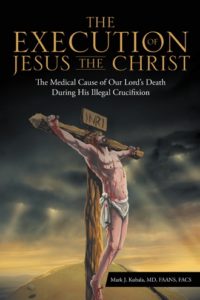In this space, WestBow Press publishes articles written by our authors in which they share some aspect of their self-publishing journeys. The following blog is from Mark J. Kubala, MD, FAANS, FACS, author of “The Execution of Jesus the Christ: The Medical Cause of Our Lord’s Death During His Illegal Crucifixion”. To begin your self-publishing journey, get a free WestBow Press publishing guide today!
Inspiration for My Book
 As a Christian neurosurgeon, I first read Dr. Barbet’s book A Doctor at Calvary early on in my career. In this seminal book, Dr. Barbet proposed the theory that Jesus died from asphyxiation (strangulation) based on observations during World War One that prisoners hung by their arms tied over their head, with no foot support, could not exhale. Dr. Barbet felt that when Jesus’ arms were nailed to the crossbeam, and then the crossbeam was lifted on the shaft, his body sagged (dropped down). He proposed that in this position Jesus was unable to exhale, leading to asphyxiation. Even Dr. Barbet’s partner, Dr. P. J. Smith commented in Appendix II of this book, “This theory is not supported by some of the evidence set out in the book”. However despite the lack of scientific evidence, the theory that Jesus died from asphyxiation has been taught for seventy years.
As a Christian neurosurgeon, I first read Dr. Barbet’s book A Doctor at Calvary early on in my career. In this seminal book, Dr. Barbet proposed the theory that Jesus died from asphyxiation (strangulation) based on observations during World War One that prisoners hung by their arms tied over their head, with no foot support, could not exhale. Dr. Barbet felt that when Jesus’ arms were nailed to the crossbeam, and then the crossbeam was lifted on the shaft, his body sagged (dropped down). He proposed that in this position Jesus was unable to exhale, leading to asphyxiation. Even Dr. Barbet’s partner, Dr. P. J. Smith commented in Appendix II of this book, “This theory is not supported by some of the evidence set out in the book”. However despite the lack of scientific evidence, the theory that Jesus died from asphyxiation has been taught for seventy years.
Past Research
In 1986 there was an article in the Journal of the American Medical Association from the Mayo Clinic about the crucifixion of Jesus. This created quite a stir, as many felt it was inappropriate to have a discussion of the death of Jesus in a medical journal. Since I had part of my training at the Mayo Clinic, this article prompted my interest in the study of the crucifixion of Jesus. I read many books.
Dr. Frederick Zugibe, a forensic pathologist, in his book The Crucifixion of Jesus, a forensic inquiry, carried out experiments with young human volunteers and showed that as long as the feet are stabilized there is no difficulty in breathing in the sagging position. He did not go into great detail as to what was the cause of Jesus’s death. The majority of his book discusses the evidence for the Shroud of Turin. This stirred my interest as to what was the main factor in Jesus dying so soon from his crucifixion.
What the Witnesses Saw
To answer this question, I turned to the Bible. The New Testament is replete with many quotations that say Jesus died “by the loss, or shedding, of his blood.” The only writer that was at the cross during Jesus’s crucifixion was John. However, the other writers must have known and talked to witnesses to the crucifixion, or talk to someone who knew someone who knew the witnesses. Since the eyewitnesses to Jesus’s dying said that he lost a lot of blood, the question came up, then where did this blood loss come from.
In my book, I reviewed the events as they unfolded during the passion of Jesus Christ. I present a new theory as to where this blood loss came from that led to such an early death. My book has been reviewed by many physicians who agree with my conclusion. How wondrous it is to realize that on Good Friday afternoon, as the high priests were slaughtering the lambs as an animal sacrifice, Jesus bled to death for our sins, as our sacrifice for the new Passover.
– WBP –
WestBow Press authors who’d like to share a 350-600 word experience related to the self-publishing of their books are invited to do so through the Blog Guidelines Page. WestBow Press reserves the right to edit stories for content, grammar, punctuation, and length

